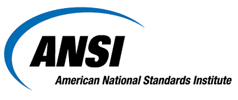The American National Standards Institute, otherwise known as ANSI, helps promote and support standards and conformity assessment systems. Essentially, the ANSI organization works to facilitate standards across industries. The ANSI meaning implies an accredited process exists for a governing body.
“ANSI facilitates the development of American National Standards (ANS) by accrediting the procedures of standards developing organizations (SDOs). These groups work cooperatively to develop voluntary national consensus standards. Accreditation by ANSI signifies that the procedures used by the standards body in connection with the development of American National Standards meet the Institute’s essential requirements for openness, balance, consensus and due process.”
Ultimately, ANSI serves as an administrator within the United States private sector to create standard requirements that govern the consensus development process. These ANSI Essential Requirements help ensure an “open and fair” process for all the stakeholders involved in each set of standards. Additionally, these standards are part of the American National Standards (ANS), so the “open and fair” process means market participants are involved in the creation of the standards.
“The Institute’s definition of openness has many elements, but basically refers to a collaborative, balanced and consensus-based approval process. The content of these standards may relate to products, processes, services, systems or personnel.”
Finally, a certified standard under ANSI means:
- Consensus was reached by representatives from impacted and interested parties.
- Standards underwent public review with the option for anyone to submit comments.
- Comments from the consensus body, including public comments, responded to in good faith.
- Appeal process is required.
What is the history of ANSI?

The ANSI organization was founded in 1918 by five engineering societies and three government agencies as a non-profit organization. For over 100 years, ANSI has remained a private, non-profit membership organization supported by private and public entities. Since its formation, ANSI continues to support its primary mission of enhancing the “global competitiveness of U.S. business and the American quality of life by promoting and facilitating voluntary consensus standards and conformity assessment systems and promoting their integrity.”
Currently, ANSI represents the interests of its more than 1,200 members and accredited more than 240 standards developers, while certifying over 11,500 American National Standards.
Interestingly, the standards space remains quite large. Estimates indicate that there are hundreds of “traditional” standards developing organizations (SDOs) in the United States. And, the 20 largest SDOs produce roughly 90% of the industry standards. Since the outset, ANSI provides accreditation to these underlying SDOs, which help individuals working within various industries have confidence in their industry standards.
As ANSI has grown over time, so has their influence and impact on standards. For example, ANSI is the official U.S. representative to the International Organization for Standardization (ISO). Additionally, and, via the U.S. National Committee, the International Electrotechnical Commission (IEC). Additionally, ANSI also maintains the following affiliations:
- ANSI National Accreditation Board (ANAB) is a member of the International Accreditation Forum (IAF) and the International Laboratory Accreditation Cooperation (ILAC).
- ANAB is a member of the Asia Pacific Accreditation Cooperation (APAC) and the InterAmerican Accreditation Cooperation (IAAC).
What does ANSI mean for aerial lift operators?
Aerial lift operators rely on ANSI accreditation through standards set by the Occupational Safety and Health Administration (OSHA). For example, OSHA defines aerial lifts as any vehicle-mounted device utilized to raise person, which includes:
- Extendable boom platforms
- Aerial ladders
- Articulating (jointed) boom platforms
- Vertical towers
- Any combination of the above.
As part of the standards, OSHA provides guidelines on proper training, which helps mitigate workplace safety issues. In essence, ANSI means that OSHA followed an accredited process to develop underlying standards that impact aerial lift operations. Additionally, as part of a new set of standards, ANSI 92.2, OSHA published the proposed changes with the Federal Registry (which is open to public comment). The initial proposal occurred in September 2016 and finally took effect in 2020. As a result of the “open and fair” process, establishing standards (and making changes) definitely takes time, but helps ensure all participants maintain a voice throughout the process.
Finally, under the A92.2 standards, ANSI means aerial lift operators must adhere to workplace inspection guidelines, which includes how frequently inspections occur and what must be inspected. Also, the standards mean inspections must be performed by a qualified person and be conducted no more than 13 months after the previous inspection. Plus, the A92.2 standards update fall protection guidelines. As a result of the A92 standards, operators must remain up-to-date in industry changes and workplace inspections to ensure they meet current ANSI certifications.
Why do standards matter?
Standards matter because they establish a set of criteria that maintains consistency between products within the same industry. For example, “standards help ensure that a light bulb fits a socket, that you can take money out of any ATM in the world, and plugs for electrical appliances fit outlets.”
As a result, ANSI means SDOs utilize a uniform process to create industry standards.


